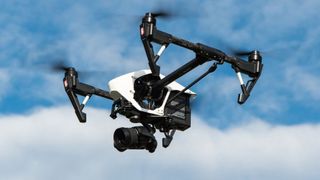AT&T is launching drones into the sky as mobile 5G hotspots
Patchy internet in the countryside? No problem

Telecommunications giant AT&T has developed drones capable of beaming down 5G signal to an area with patchy connectivity.
In true dad joke style, the drone has been named the 5G Flying COW (an acronym for Cell on Wings). In testing, it was able to provide an area of some 10 square miles with strong 5G signal, AT&T says.
“We had intermittent, weak LTE signal at the flight location before we launched the 5G Flying COW,” said Ethan Hunt, Unmanned Aircraft Systems (UAS) Principal Program Manager, AT&T. “We flew the drone up to about 300 feet, turned on the signal and it began transmitting strong 5G coverage to approximately 10 square miles.”
Flying for hours
While there may be many use cases for drone-based mobile hotspots, AT&T’s first idea is to have them help first responders, mountain rescue services and the like.
The benefits for teams works in rugged conditions are obvious, providing a reliable connection with which to communicate with one another and the people they are trying to help.
The usual problem with drones is their stamina. Today’s flying machines, even the most advanced ones, can only stay in the air for a couple of hours, while consumer-grade products rarely make it for longer than 40 minutes. Right now, AT&T’s devices are tethered, but that’s also being worked on for future iterations.
“We are currently working through many exciting technical challenges to expand the capabilities of our Flying COWs,” said Art Pregler, Unmanned Aircraft Systems (UAS) Program Director, AT&T.
Are you a pro? Subscribe to our newsletter
Sign up to the TechRadar Pro newsletter to get all the top news, opinion, features and guidance your business needs to succeed!
“We’re working to autonomously fly without tethers for months without landing, using solar power to provide secure, reliable, and fast 5G connectivity to large numbers of users over wide geographic areas. This solution may one day help bring broadband connectivity to rural and other underserved communities across the US and elsewhere.”
Elon Musk’s Starlink is working on providing the entire world with satellite internet connectivity, but until that happens, flying drones beaming down super high-speed internet is a welcome next step.
Sead is a seasoned freelance journalist based in Sarajevo, Bosnia and Herzegovina. He writes about IT (cloud, IoT, 5G, VPN) and cybersecurity (ransomware, data breaches, laws and regulations). In his career, spanning more than a decade, he’s written for numerous media outlets, including Al Jazeera Balkans. He’s also held several modules on content writing for Represent Communications.
Most Popular


